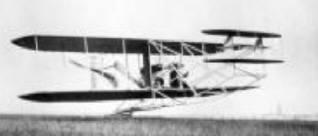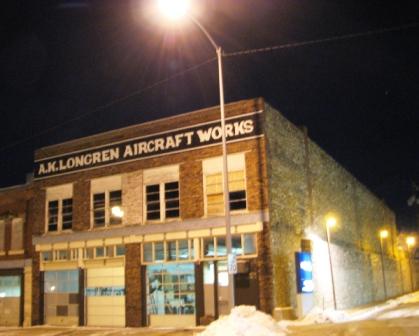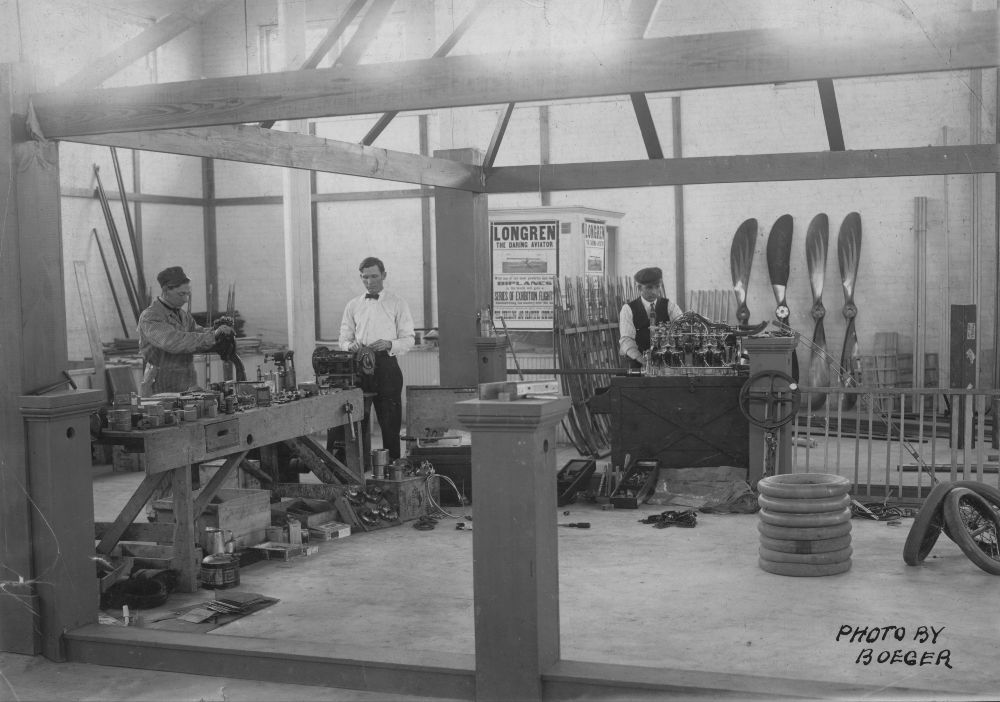 Return to
Return toAviation Answer-Man
Gateway
 Return to
Return to
Aviation Answer-Man
Gateway
 Return to
Return to

Albin K.
Longren
On the 100th Anniversary of Kansas
Aviation
Biographic Notes
Sept. 2, 2011
by Richard Harris,
(316)371-9079
Kansas Aviation Historian
for the
Kansas 150 Speakers Bureau
of the Kansas Humanities Council
Click to enlarge.
On Sept. 2, 1911, Albin Kasper Longren, of Topeka, became the first successful Kansas aviator and airplane-maker to actually fly in Kansas (for photo of Longren's first plane, in flight, click here ). Longren, with the help of correspondence courses in business and engineering, was a self-taught engineer and machinist, who appears to have made a huge mark on aviation, without being terribly conspicuous.
(The following info is chiefly based on research by his main biographer & champion, Rev. Richard "Dick" Taylor, of Berryton, KS (near Topeka), now of Andover, KS; supplemented by other reputable historic sources):
Among Longren's companies, employment, or consulting clients, are...:
1911-1914
Young Aviation co., Topeka, KS
(built 1st planes)
(his own company?)

1914-1918, and
1919-1924 (bankruptcy)
1924-1930s
Longren Aircraft, Topeka, KS - moved
1930 to Kansas City, MO; moved 1938 to Torrance, CA (his own company, with other workers; apparently concurrent with intermittent
employment elsewhere.) (Photos at right. Exterior shot is of building as it appears in downtown Topeka, today.)
July 1918 - June 1919
U.S. Army aviation research center,
McCook Field, Dayton Ohio (ultimately as Chief Inspector) (NOTE: A glowing 1941 letter of reference from Lt.Col. F.O.
Carrol of the Exp.[erimental?] Engineering Section of the War Dept. Air Corps,
at McCook's neighbor, Wright Field, says "Some of the engineers of the
Matieral Div. have known Mr. Longren for the past 12 years...," implying
that Longren was actively engaged with them since 1929.

1927
Spartan Aircraft, Tulsa, OK (Spartan C-3 biplane; Spartan would later be a
pioneer in aluminum-shell light airplanes, with its Spartan Executive.)
Feb 1930-?
Butler Aircraft, Kansas City, MO
(design consultant on Butler Blackhawk)
1933
Luscombe Aircraft, Kansas City, MO
(design/manufacturing engineer on
Luscombe Phantom,
pace-setting design of
modern aluminum-shell aircraft).
1934-1939
Cessna Aircraft, Wichita, KS
(Vice President; provided Cessna with his technology and use of his
patents; Cessna, in 1940s, lept ahead of
competition by being first major light-plane maker to switch to aluminum-shell
aircraft, along with neighboring Beechcraft. Those two companies survived the
general aviation "shakeout" of the 1940s/1950s, quickly becoming the
dominant force in light planes, rivaled only by Piper.)
1943
LONGREN RETIRES during World War II
(newspaper clipping says his techniques
have been adapted by Douglas, Lockheed, Vega, Northrup [Northop?] & Boeing
in dozens of fighters & bombers.
It is quite likely Longren consulted for one or more of them; in 1938 he moved his business to the Los Angeles area industrial suburb of Torrance, California, in the middle of most of those companies' major aircraft factories, where he remained until his death in 1959.)
HISTORY of Albin Longren & his
work:

On Sept. 2, 1911, Albin Longren flew his "Longren Flyer" (a scratch-built imitation of the Curtiss Pusher) from a field just outside of Topeka, Kansas.
NOTE: Although Kansas-bred Clyde Cessna had flown months earlier in HIS home-built plane, it was from the Salt Plains at Jet, near Enid, Oklahoma -- NOT in Kansas. (Cessna DID return to Kansas the following year, beginning a legendary aviation career, there.)
Over the next several years -- with a break for military service during World War I -- Longren would produce a few dozen planes, including America's first composite-shell aircraft -- today's "latest" cutting-edge construction technique for aircraft.
Longren's military service in late World War I (and shortly thereafter) included a stint at McCook Field, Dayton, Ohio (home of the Wright Brothers) which was the military's main aviation-research center. Longren reportedly rose to the lofty status of Chief Inspector, earning high praise from superiors, before returning home in about 1919.
It is worth noting that Longren was already apparently showing interest in "monocoque" / "semi-monocoque" construction techniques -- essentially creating a hollow-shell airplane whose exterior skin was also its structure. This technique, once mastered and accommodated by the availability of "aircraft grade" aluminum during World War II, would fundamentally change the way planes were built.
Longren's postwar attempts to revive the Longren airplane company were noteworthy, particularly for the Longren AK Fibre Sport -- America's first "composite-shell" plane manufactured in quantity -- of which he produced about 10.
In perhaps his most important contribution to aviation, Longren managed to develop a superior method for shaping the complex curves of the modern, aluminum-shell airplane, by "stretch forming" the aluminum sheeting over wooden forms.
The result was a
much-faster, much-cheaper way to build aluminum-shell airplanes, radically
increasing their practicality and profitability, almost certainly a key factor
in the shift to such airplane design for most of the mid- to late-20th Century
-- starting mainly with World War II, greatly increasing America's modern plane-manufacturing
productivity during the critical war years.
Through a bankruptcy in 1924, Longren's assets -- including his airplane designs and manufacturing machinery -- were largely sold off to the
Alexander Film Co.
, in Denver. They used Longren's assets to start the
Alexander Aircraft Co.,
soon
one of the world's top sellers of airplanes
-- igniting the legendary career of airplane designer
Al Mooney
-- who would later bring
Culver Aircraft Co.
to Kansas (in Wichita), and twice start
Mooney Aircraft
there, as well. Today, the still-busy
Mooney Aircraft Co.
(now in Texas) remains one of the world's most respected lightplane manufacturers).
Yet bankruptcy did not end the inventive entrepreurship of Albin Longren, who continued to innovate newer, better airplane design and construction techniques. During the decade before the war, Longren appears to have
been a technical consulting vagabond, traveling from aircraft company to aircraft company, sharing
his technological insights, particularly about aircraft manufacturing
technology.
In the early 1930s, Longren worked for
Luscombe Aircraft,
in Kansas City,
developing the
Luscombe Phantom,
the first popular light plane to use
aluminum-shell design. He also served as
consultant to other companies, as well.
In the mid/late-1930s, Longren joined Cessna Aircraft as Vice President --
trading in rights to use his patents and inventions.
During the following years, Cessna would leap
ahead of most competitors largely on the strength of its exceptional expertise
-- apparently first provided by Longren -- in manufacturing modern aluminum-shell
airplanes.
Alumni of Longren's company went on to found small aircraft manufacturers throughout the Kansas City area, ulimately attracting World War II factories (of North American, Allison and others) that built many of the key airplanes (like B-25 Mitchell bombers) and airplane engines of the war.
But his greatest influence seems to have been in providing a technology to ALL of aviation that made the modern airplane much more practical and affordable to produce, improving the economics and popularity of aviation, worldwide.
TODAY, the industry is just beginning to adopt his even more advanced notion: carbon-fiber composite-shell aircraft -- first developed in America by Longren around World War I -- now sweeping the aviation world.
- Albin K. Longren - Kansapedia - Kansas Historical Society
- Albin Longren - Kansas Historical Society
- Cool Things - Longren's Biplane - Kansas Historical Society
- on KansasMemory-org:
- Albin K. Longren - Kansas Memory
- Albin K. Longren airplane - Kansas Memory
- Albin K. Longren's first flight - Kansas Memory
- Albin Longren's first airplane - Kansas Memory
- Longren aircraft factory, Topeka, Kansas - Kansas Memory-org
- New Longren airplane - Kansas Memory-org
TOPEKA CAPITAL-JOURNAL
- 'Birdman' took flight 100 years ago CJOnline.com
- 'Birdman' took flight 100 years ago - Topix
- ALBIN K. LONGREN Search Topeka, KS CJOnline.com
- ALBIN LONGREN Search Topeka, KS CJOnline.com
- "Topeka Remembers" VIDEO - CJOnline.com
- multiple videos showing Longren planes
- and other Topeka history.
WICHITA EAGLE & BEACON
LAWRENCE JOURNAL-WORLD
AUGUSTA CHRONICLE
- AFHSO.af.mil-AFD-101101-028.pdf
- AvHistMILITARY_KansasAvPioneers_cQOoso06 oo 1-PDF
- DUCTED FAN RESEARCH - MILITARY
AEROFILES.com